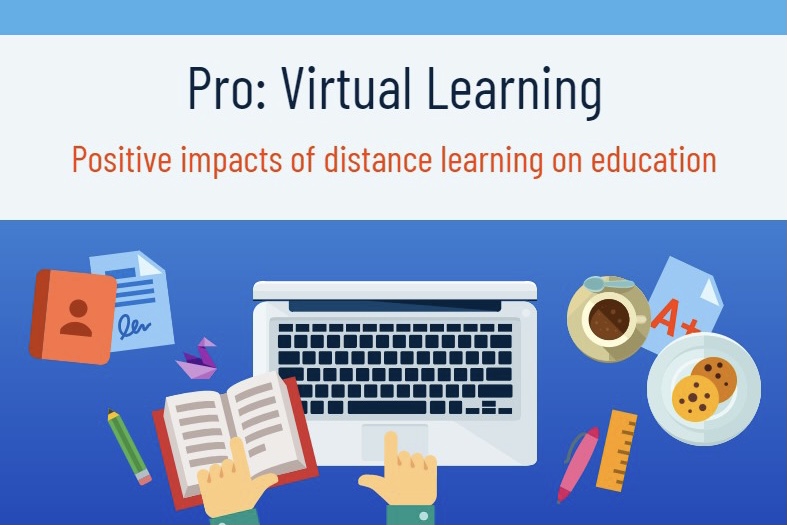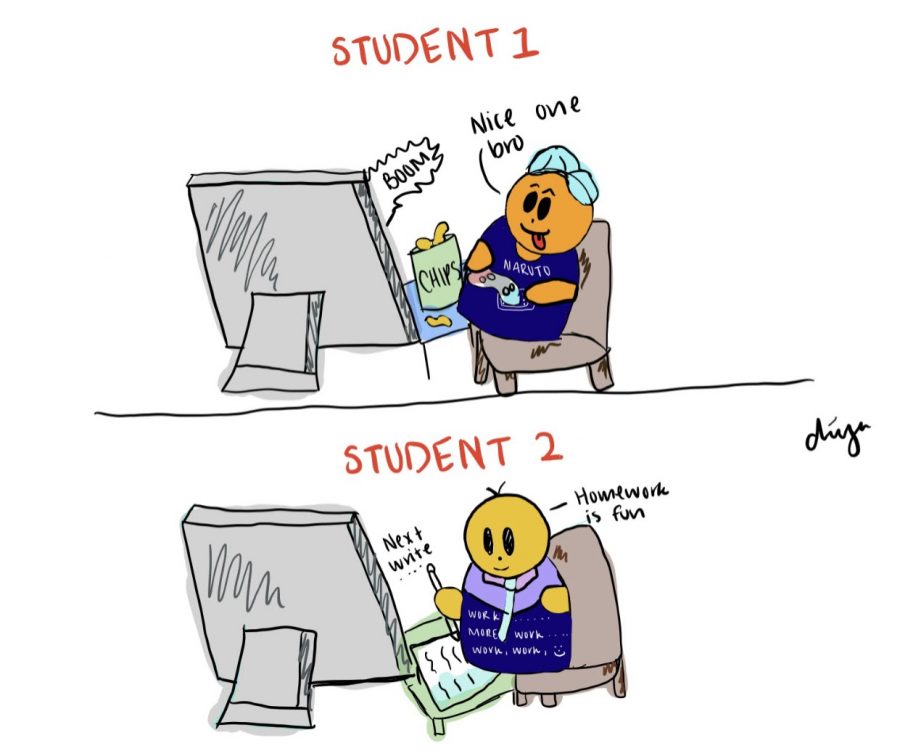Pro/Con: Is online learning effective?
December 10, 2020
Pro: Virtual learning provides school-life balance
Coppell ISD students began virtual learning on March 23 and resumed Aug. 17 with updated grading policies and attendance requirements. The Sidekick advertising and circulation manager Trisha Atluri discusses how increased flexibility provided by remote learning benefits virtual students.
When you’re faced with four assignments daily on top of several projects and tests to study for, it’s hard to stay motivated and get yourself to start any of your work. For many students, the stress of schoolwork and deadlines is immobilizing.
When school resumed for Coppell ISD students after an extended spring break, virtual learning was mandatory for everyone. Class schedules were flexible, with assignments due at the end of the week and no required Zoom classes.
Currently, students have the option to attend school in-person or take classes virtually. Virtual learners can access their classwork through district issued devices and Wi-Fi hotspots set up throughout the district. Coppell High School Principal Laura Springer spoke on the importance of equity when classes are split into two groups.
“We should treat both online learners and in-person students as one class,” Springer said. “Just because you’re somewhere different doesn’t mean you can’t be working together and getting to know each other.”
Online classes consist of daily Zoom sessions and mandatory attendance check-ins on Schoology. While students may be accustomed to a rigid bell schedule and teacher supervision, these revised requirements provide the basic structure that high school students need. We have more freedom in the way we learn, and we are able to construct schedules that prioritize urgent tasks.
“Virtual education has helped me with my anxiety, because now I know what I have to do and when I have to get it done,” CHS junior Dawson Marold said. “I can do my work on a workload basis rather than follow a schedule where I have to go to a certain class for an hour and a half.”
The new structure has allowed us to be more responsible with the way we manage our work, which is beneficial in the long run. In the near future, most students will be in college, where classes are more spread out and students must manage their own schedules.
“If you want to use school hours to work on something other than schoolwork, that’s an option,” CHS junior Devika Kohli said. “That prepares us a lot more for when we create our own schedules. It helps us figure out how to allocate our time and prioritize the most important things.”
While students’ mental states are declining as a result of isolation, the increase in anxiety is more closely linked to pandemic concerns, such as physical health of loved ones, increased uncertainty and sudden school closures.
In fact, the increased flexibility with the new structure has had a positive impact on mental health. With more time in the day to be productive, we also have more time for breaks and self-paced learning.
Additionally, CISD has several resources for students who are struggling during this time, including crisis counselors students can contact when they feel overwhelmed. Springer emails a weekly newsletter, and Superintendent Dr. Brad Hunt shares the CISD informed newsletter in order to update the community and maintain a sense of unity for people who feel they are missing out.
“I want to give everyone the opportunity to feel like they’re part of us,” Springer said. “I don’t want anyone to feel they’re separated. We are all one school, one family.”
In order to succeed in an online learning environment, students need to be internally motivated. Motivation is vital to success regardless, so it is important for students to learn this now. Independent learning is key to being a successful virtual student, and it’s also necessary for college students living on their own with flexible schedules.
“Motivation has to come from inside because there’s not always a teacher telling you exactly what you have to do, and it’s harder to ask questions,” Kohli said. “If you have a question, you have to be self motivated about reaching out to your teacher because they won’t reach out to you often. You have to advocate for yourself.”
This concept can also be applied to efforts to maintain relationships through the pandemic. Learning from home allows us the opportunity to reach out to friends from school when we want to. It teaches us to put in the effort to stay in touch when regular connections are lost, which is a challenge we would face after graduation anyway.
We have the resources to succeed as long as we can keep ourselves motivated. Months of virtual learning have been a period of growth for most students, a period where we have learned more about ourselves and the way we learn than ever before. With this knowledge, we can be more successful in our education.
Follow Trisha (@trishatluri) and @CHSCampusNews on Twitter.
Con: Online learning necessary but not as effective
Through the pandemic, a majority of Coppell ISD students are attending school online. The Sidekick staff writer Manasa Mohan discusses that although online students have the same curriculum, they have different mindsets and methods regarding online learning.
A high school virtual learner faced new and unknown circumstances, including a school environment in a bedroom and the only outlet of social interaction being a Zoom call with teachers and peers.
Overwhelmed by new changes, online students are confronted with unique difficulties, many of which are tough for students to tackle on their own. These changes can impact their academic performance because students are having a hard time finding solutions to their problems, and on top of that, students have the responsibility to perform well in school and participate in any extracurricular activities.
One of the biggest hindrances to online learning is the lack of social interaction between students, peers and teachers, which has negatively affected students’ academic performance.
“Normally, when you can talk to people [in person], you can help each other understand [topics],” Coppell High School junior Khushi Gupta said. “In Zoom calls, whenever [teachers] put us in breakout rooms, a lot of people don’t talk immediately and it is hard to interact with people when you can’t converse as easily.”
According to New York University, social relationships have a direct impact on a student’s academic performance and these relationships have been proven to boost students’ academic motivation, engagement and achievement.
The failure rates for the previous nine weeks occurred when some students were online and participating in distance learning for three weeks. Families had the choice of whether they wanted to return or not, which produced significantly higher failure rates than those from previous years. According to Coppell ISD’s director of communications Amanda Simpson, 66 CHS learners were notified [on Nov. 17] that they were in danger of not passing one of their academic core classes but, considering the second nine weeks, had an opportunity for credit recovery.
Since most students are not in person and cannot ask questions immediately after learning a topic, they are finding it more difficult to check their understanding of topics. Although email does provide a solution to this problem, students find it challenging to phrase their questions adequately.
“When you’re in person, the teacher is there, so if you have questions, you have more access to your teacher, and they can answer anything,” CHS sophomore Hiranya Akarapu said. “But, say you were to run into a problem online, how are you supposed to tell your teacher? And although email does solve this issue, it may be hard for a student to articulate their words clearly.
“Over Zoom…people are hesitant to ask questions which makes it difficult to figure out if you have actually mastered the content being taught.”
Despite the fact that teachers and students alike have adapted to the situation incredibly well, it does not change the fact that online learning is simply not as effective. The lack of social interaction impacts students’ academic performance, and students no longer truly have the ability to ask a question and immediately receive a response from a teacher
With the safety online learning provides, the everyday obstacles seem to trump the benefits and oftentimes make online learning pale in comparison to in person learning.
Follow @CHSCampusNews on Twitter

